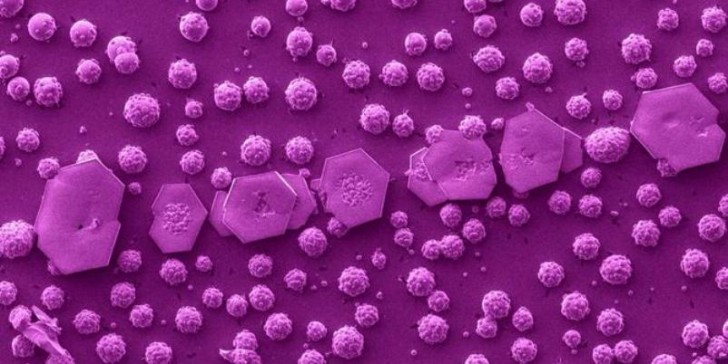Are quantum dot TVs – and their toxic ingredients – actually better for the environment?

“The future is bright, the future is … quantum dot televisions”, The Conversation reported on January 6th. And judging by the buzz coming from the annual Consumer Electronics Show (CES) that’s right – the technology is providing manufacturers with a cheap and efficient way of producing the next generation of brilliant, high-definition TV screens.
But the quantum dots in these displays also use materials and technologies – including engineered nanoparticles and the heavy metal cadmium – that have been a magnet for health and environmental concerns. Will the dazzling pictures this technology allow blind us to new health and environmental challenges, or do their benefits outweigh the potential risks?
Answer’s not black and white
Quantum dots are a product of the emerging field of nanotechnology. They are made of nanometer-sized particles of a semiconducting material – often cadmium selenide. About 2,000 to 20,000 times smaller than the width of a single human hair, they’re designed to absorb light of one color and emit it as another color – to fluoresce. This property makes them particularly well-suited for use in products like tablets and TVs that need bright, white, uniform backlights.
There are of course other chemicals, such as phosphor, that fluoresce and are used in consumer products. What is unique about quantum dots is that the color of the emitted light can be modified by simply changing the size of the quantum dot particles. And because this color-shifting is a physical phenomenon, quantum dots far outperform their chemical counterparts in brightness, color and durability.
Unfortunately, the heavy metal cadmium used in the production of many quantum dots is a health and environmental hazard. Under the European Restrictions on Hazardous Substances directive, its use is restricted in electronic equipment. And cadmium and cadmium compounds have been classified as carcinogenic to humans by the International Agency for Research on Cancer.
On top of this, the potential health and environmental impacts of engineered nanoparticles like quantum dots have been raising concerns with toxicologists and regulators for over a decade now. Research has shown that the size, shape and surface properties of some particles influence the harm they are capable of causing in humans and the environment; smaller particles are often more toxic than their larger counterparts. That said, this is an area where scientific understanding is still developing.
Together, these factors would suggest caution is warranted in adopting quantum dot technologies. Yet taken in isolation they are misleading.
Quantum dots under glass
The quantum dots currently being used in TVs are firmly embedded in the screens – usually enclosed behind multiple layers of glass and plastic. As a result, the chances of users being exposed to them during normal operation are pretty much nil.
The situation is potentially different during manufacturing, when there is a chance that someone could be inadvertently exposed to these nanoscopic particles. Scenarios like this have led to agencies like the US National Institute for Occupational Safety and Health taking a close look at safety when working with nanoparticles.While the potential risks are not negligible, good working practices are effective at reducing or eliminating potentially harmful exposures.
End-of-life disposal raises additional concerns. While the nanoparticles are likely to remain firmly embedded within a trashed TV’s screen, the toxic materials they contain, including cadmium, could well be released into the environment. Cadmium is certainly a health and environmental issue with poorly regulated e-waste disposal and recycling. However, when appropriate procedures are used, exposures should be negligible.
These concerns could be enough to tip the balance against using quantum dots in consumer electronics for some. But they only tell part of the story because these small, bright particles also come with environmental benefits.
But there are bright benefits
Quantum dot TVs can be upward of 20% more energy efficient than conventional LED TV screens. And because quantum dots are such an efficient source of bright light, the amount of light-emitting material in these screens (as low a milligram of cadmium in some models) may actually reduce the overall amount of toxic materials used.
These energy and material savings translate into reduced environmental and health impacts. But are they enough to justify the use of a potentially toxic material?
The company QD Vision has grappled with precisely this question. In developing quantum dots for products like Sony’s TCL Quantum Dot TV (debuting at CES this year), the company explicitly adopted an approach to responsible development that considered health and environmental impacts. As a result, in 2014 they won the Presidential Green Chemistry Challenge Award from the US Environmental Protection Agency (EPA).
Although it seems counter-intuitive, analysis by the company that was made available to the EPA showed QD Vision’s products lead to a net decrease in environmental cadmium releases compared to conventional TVs. Cadmium is one of the pollutants emitted from coal-fired electrical power plants. Because TVs using the company’s quantum dots use substantially less power than their non-quantum counterparts, the combined cadmium in QD Vision TVs and the power plant emissions associated with their use is actally lower than that associated with conventional flat screen TVs. In other words, using cadmium in quantum dots for production of more energy-efficient displays can actually results in a net reduction in cadmium emissions.
This is a neat trick, and it eloquently demonstrates the dangers of jumping to conclusions over risks without seeing the full picture. It does, however, depend on a commitment to responsible innovation and development that considers future health and environmental impacts.
This week at CES, the future of quantum dot televisions is certainly shining bright. With smart approaches to balancing risks and benefits, there’s no reason why this light shouldn’t continue to shine – as long as manufacturers and consumers keep their eye on the big picture.
Source: Andrew Maynard, 7th of Januar 2015 on The Conversation
Image Source: Argonne National Laboratory